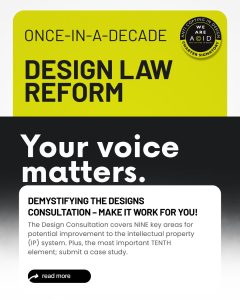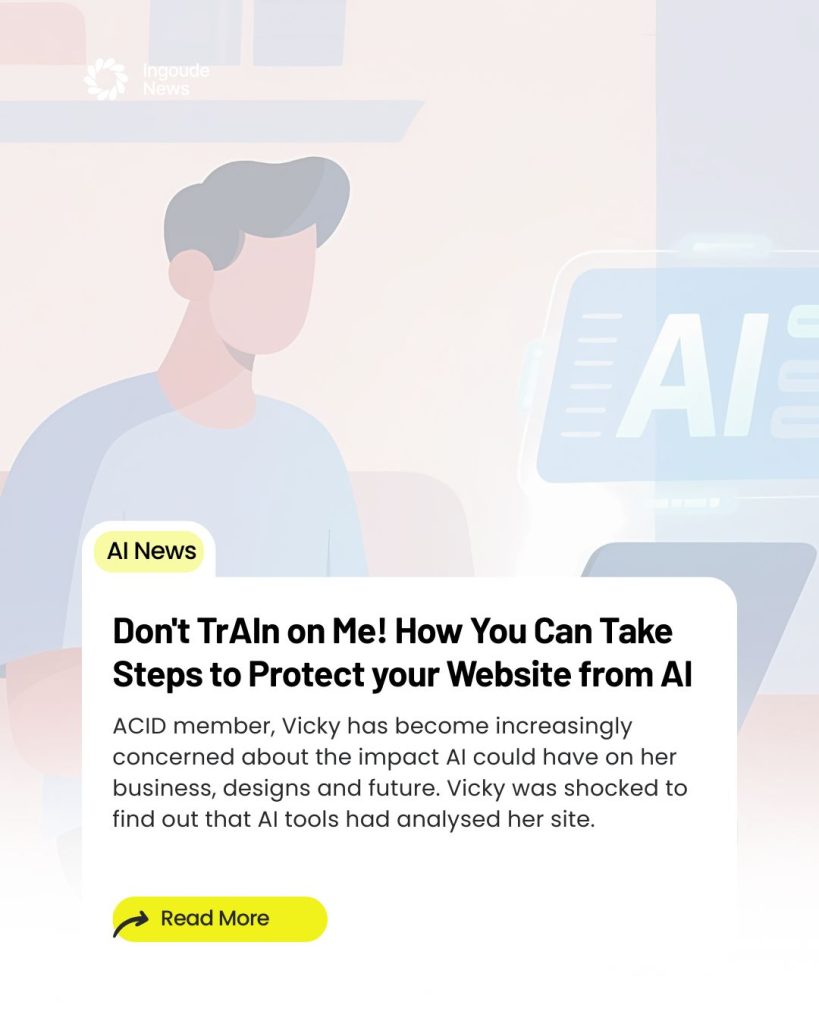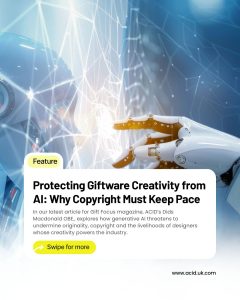

Meet Vicky Yorke, Owner and Designer at Vicky Yorke Designs. An ACID member for many years, Vicky is a surface pattern designer and illustrator with oodles of experience and artistic ability. Not only that but Vicky always has a keen eye on all things IP, displaying terms and conditions and the ACID logo on her website to deter any would be copycats.
However, like many of our ACID community, Vicky has become increasingly concerned about the impact AI could have on her business, designs and future. Despite diligently taking steps to opt out of social media AI use, Vicky was shocked to then receive an email from www.dondo.com advising that their AI tools had analysed her site and made recommendations:

When she clicked ‘view analysis’, Vicky was shocked at the level of detail the report went into, including extensive detail of her brand voice.
Though the analysis had only used information freely available and outwardly facing on Vicky’s website, this nonetheless felt invasive. No permission had been given and no request made for this kind of intrusion, which highlights the concerns we all have about AI – where does the control lie and how to we restrict it’s ever-growing infiltration into our lives? Particularly for our design community, how can we be confident our designs aren’t being slowly stolen under the radar?
Vicky says “Although I know this is now routinely happening, I felt physically sick reading this. I have been actively turning off AI permissions across my social media, but don’t believe there is a way to do this on my Shopify store website. My work is also widely available online through licensing partners, so I feel I am fighting a losing battle unless an AI ‘opt-in’ system is quickly put in place…”
ACID legal affiliate Robert Lands, Partner and Head of IP & Commercial at Howard Kennedy LLP believes it is of utmost importance that the T&Cs on ACID members’ websites expressly forbid AI training and data scraping of website content. Robert suggests adding clauses not only to warn against the copying of your designs in the traditional sense, but also to prohibit the use of bots and spiders and prevent automated techniques which analyse text and data to generate information (or to develop or improve AI systems or models).
Robert points out that it’s also useful to state in the terms that such AI clause is to be treated as “an express reservation of rights, including for the purposes of Article 4(3) of the Digital Copyright Directive ((EU) 2019/790)”. The Digital Copyright Directive introduced an opt-out system in the EU for text and data mining. In other words, under EU law it is not illegal to scrape data from a website to train an AI, unless you have opted out. This is not part of UK law, but your website may have visitors from the EU- including AI visitors!
You can view Robert’s recent webinar on AI for further information.
Dids Macdonald, ACID’s Chair, Co-Founder and Director of Campaigning is at the forefront of ACID’s work on ethical AI use. Dids states “ Vicky’s experience is a shrill warning shot that without guardrails, AI can indiscriminately use data without permission. The more individuals that create their own policy about authorisation of data, the better to avoid this chilling direction of uncharted territory regarding use of your data for “training purposes” which is a sanitised word for theft. An excellent start would be to upload the following legally approved statement as a warning shot. An “opt in” system is urgently required in UK law but under the current government this is looking unlikely”
This is an agreed statement that ACID recommends on users’ websites and on social media:
“I am [or We are] a member of Anti Copying in Design (ACID). The use of [my/our] work and the data on [my/our] website and social media by generative AI models is expressly forbidden.”
So, though it may seem like closing the door after the AI horse has bolted, ACID is of the opinion that there are still a number of things you can do to keep yourself and your designs protected.
ACID CEO, Laura Newbold Breen, says “we were very pleased Vicky came to us to raise this issue and share her story with the ACID community. There is nothing worse than that stomach-dropping moment of thinking your information has been stolen or compromised but putting some simple steps in place like deterrent messaging, using the ACID logo, maintaining a strict audit trail and keeping yourself up to date by attending ACID webinars will ensure you are forewarned and forearmed”.
In summary, make sure you:
To find out more about ACID’s work, our organisation, membership benefits or anything else, please email [email protected].
Why not attend one of our free webinars? Find out about them on our events page.
Subscribe to our magazine and read all about our work and membership community.
Spread the Word

Latest News





Newsletter Sign-Up
| Cookie | Duration | Description |
|---|---|---|
| cookielawinfo-checkbox-analytics | 11 months | This cookie is set by GDPR Cookie Consent plugin. The cookie is used to store the user consent for the cookies in the category "Analytics". |
| cookielawinfo-checkbox-functional | 11 months | The cookie is set by GDPR cookie consent to record the user consent for the cookies in the category "Functional". |
| cookielawinfo-checkbox-necessary | 11 months | This cookie is set by GDPR Cookie Consent plugin. The cookies is used to store the user consent for the cookies in the category "Necessary". |
| cookielawinfo-checkbox-others | 11 months | This cookie is set by GDPR Cookie Consent plugin. The cookie is used to store the user consent for the cookies in the category "Other. |
| cookielawinfo-checkbox-performance | 11 months | This cookie is set by GDPR Cookie Consent plugin. The cookie is used to store the user consent for the cookies in the category "Performance". |
| viewed_cookie_policy | 11 months | The cookie is set by the GDPR Cookie Consent plugin and is used to store whether or not user has consented to the use of cookies. It does not store any personal data. |